Alternatives to Knots
last updated 30 April 2025.
For those who aren’t comfortable tying knots, there are a number of alternatives available.
In some cases these may require tying knots to prepare them initially, but once that is done, knots aren’t required each time the antenna is set up.
Note that some devices need to be sized appropriately for the rope you are using: most will work over a range of sizes, but may not hold if the rope is too small, and the rope may not fit if it is too large.
pre-tied loops of rope
This may seem like an odd way to avoid tying knots, but they only need to be tied once. And the more I have experimented with the other devices I describe here, the more I use them: you will see several examples in the photos.
Rock climbers call these “slings”. The length of rope can vary from less than 10 cm ( 4 inches ) to 2 m ( 6 ft ) or more, depending on the application. I suggest using bright colored rope if you have it, so you can see them better. Longer ones might be a single piece of rope with a pre-tied loop at each end.
Mostly I use these for anchors, especially to tie to inconvenient places (perhaps inside a bush) and I want the rope adjustment point out where it is easier to reach. They can also be placed around branches, posts, tree trunks, etc., where it may be difficult to use the main rope. You can then clip a carabiner to the loop to connect it to whatever else you need.
Such loops can also be tied as a Prusik Hitch, which makes it easy to adjust the tension on a rope. (It is very easy to do, so I consider this an alternative to tying a tautline hitch.)
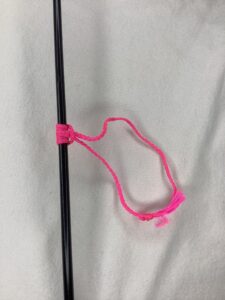
An example of a Prusik Hitch used to attach a rope to a telescoping fiberglass pole. While any small rope can be used, waxed cable lacing twine (if you remember it from long ago) is less likely to slip.
carabiners
Carabiners are classic pieces of alpine / rock climbing equipment, but smaller versions have become popular that aren’t rated for climbing. If two ropes have loops tied on the ends, it is easy to use a carabiner to connect them together. They can also attach a rope loop to an eye bolt, fence wire, tree branch, or anything else that the carabiner can be clipped around. By using small pre-tied loops of rope they can be used with larger pipes or trees. I also use carabiners in place of pulleys.
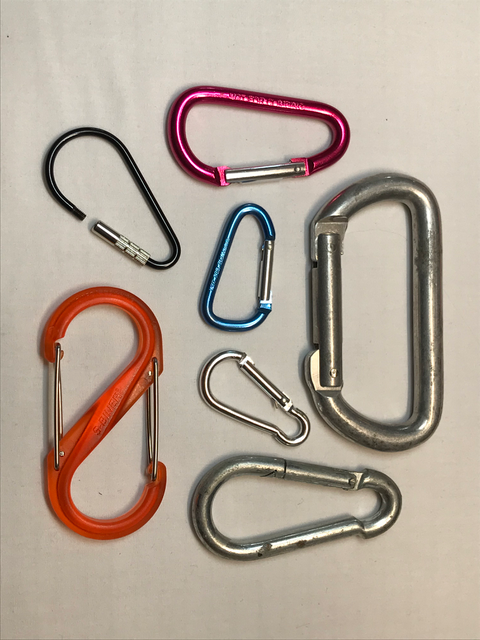
When wearing gloves, it may be easier to clip a carabiner to a metal ring (such as a key ring), rather than to a loop at the end of a rope.
While the small aluminum carabiners are very light, those concerned with reducing weight might want to use fishing snap swivels instead, or “Lanyard Clips” from a sewing supply store. These are quite inexpensive, and can be left tied to ropes or wires.
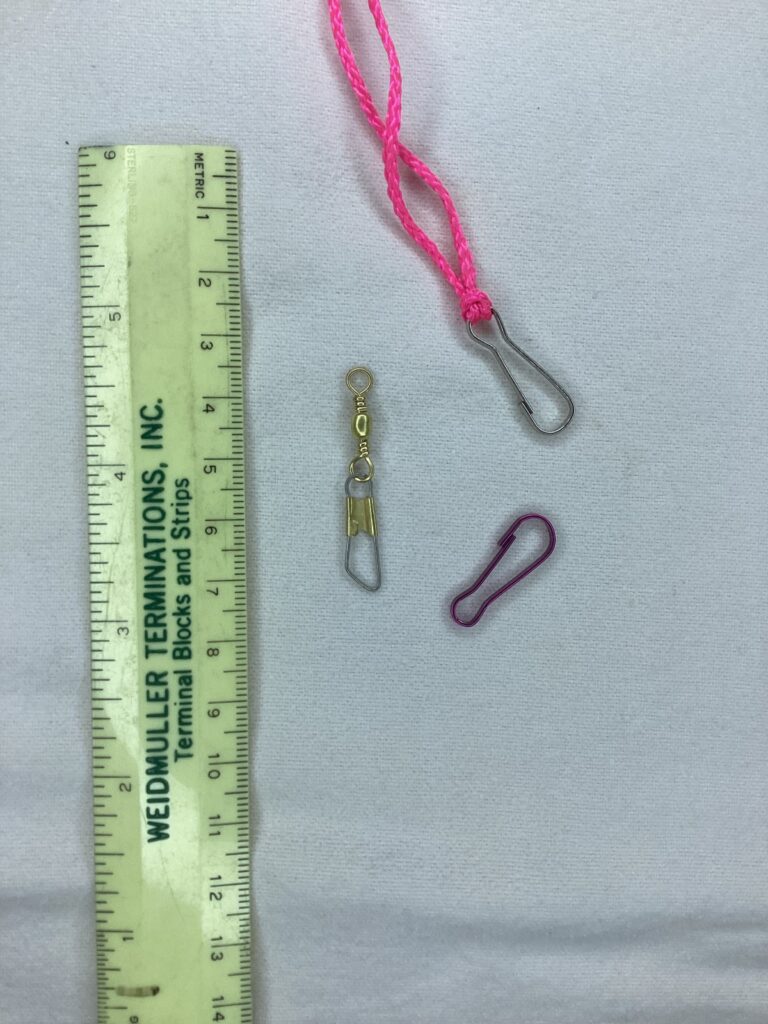
Lanyard clips and snap swivels for fishing are smaller alternatives to carabiners.
cleats
A cleat is a traditional way to secure a rope on a sailing ship, where ropes under tension needed to be tied and untied quickly. It is often used for the halyards on flag poles. They are available commercially, and can be improvised from local materials. These are particularly suited for use at the base of a mast or fixed object.
The cleat is typically mounted to a fixed object. The rope is wrapped around the cleat under tension, then the rope is wrapped back and forth across the cleat to secure it. It has the advantage that, as it is released, it provides smooth control of the rope under load.
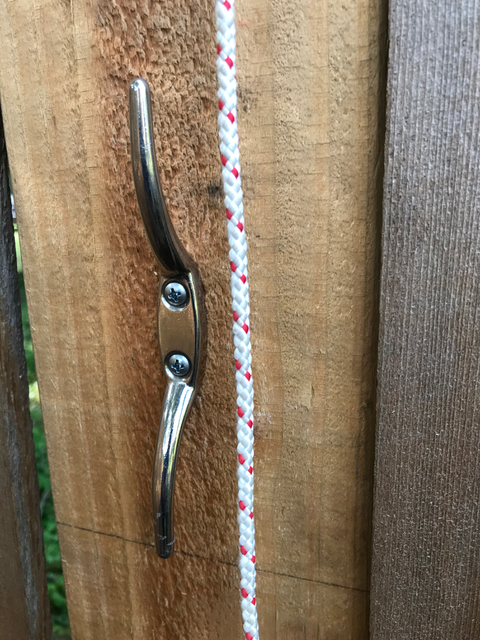
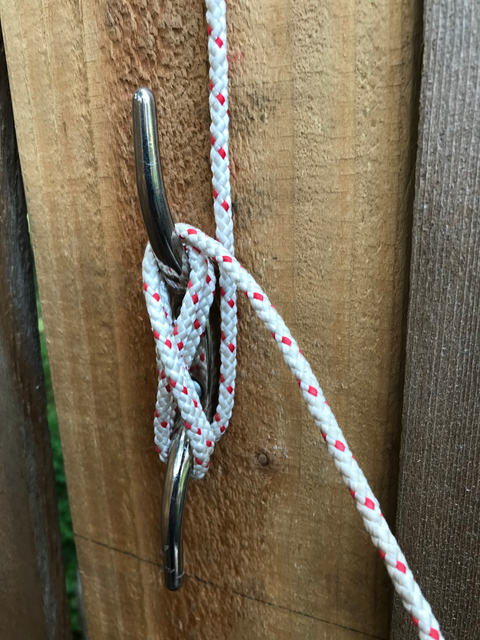
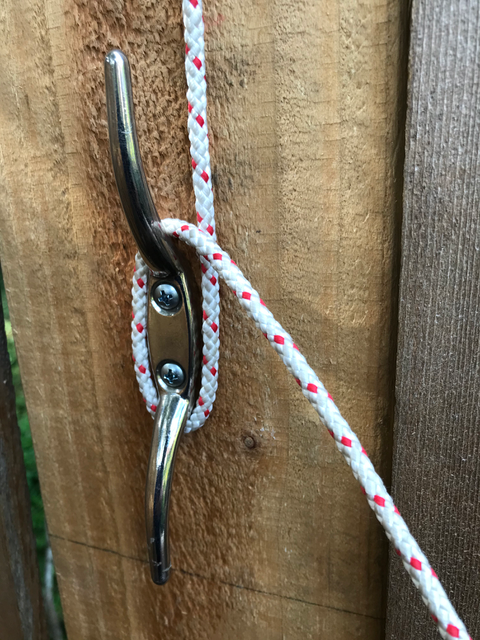
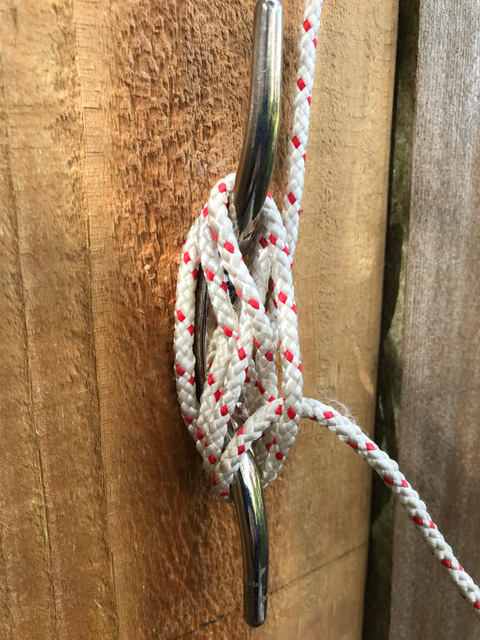
And sometimes you find a natural cleat on a dead tree, especially conifers where several branches come out at the same level:
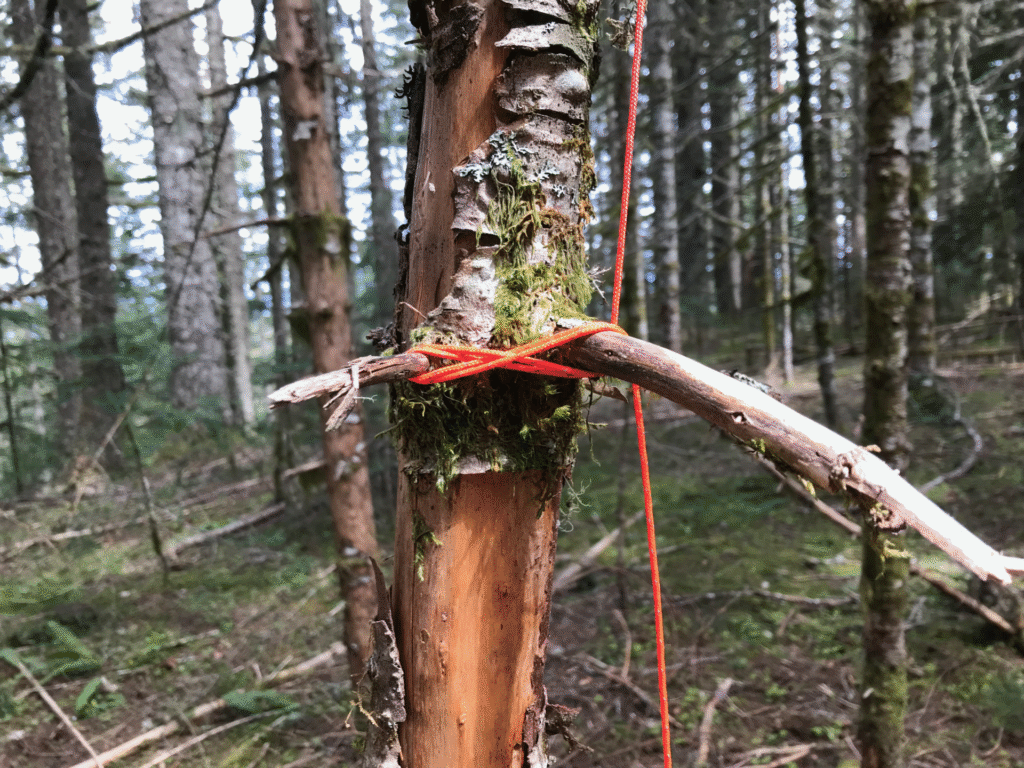
Back in my youth I remember using a “jam cleat” on a sailboat: a plastic tube with a tapered slot in one side. The rope was pulled through the tube to the desired tension, then pulled up into the slot where it wedged into the taper. Recently I saw a similar device called a “Speed Cinch”.
In this case, I mounted the Speed Cinch on the fence to hold the halyard on my antenna mast, as I often take the antenna up and down a lot when experimenting. As shown in the following photos, one side of the antenna halyard is passed through the device before the rope is tied into loop. I raise the antenna by pulling the rope through through it. To tie off the rope, I just pull it up into the slot, and the antenna will stay in place. For more secure or longer term use, I wrap the rope around to the top of the device and pull it down into the two cross-wide slots at the top.
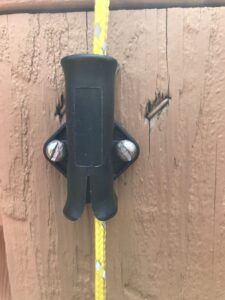
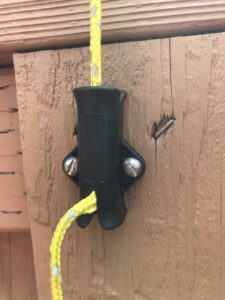
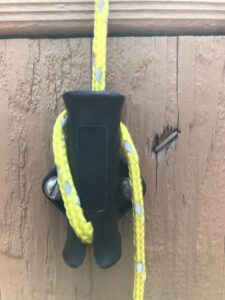
This model is rated for ropes between 3 and 6 mm ( 1/8″ to 1/4″ ), although works with somewhat smaller ropes, and with 550 Paracord.
Note that the cleat is mounted with round head wood screws (that are flat on the side that touches the wood). The more common flat head screws have a taper on the back side can break the plastic around the holes if they are screwed down too tight.
rope adjusters
There are several types of rope adjusters available that make it easy to set the tension on an antenna. Perhaps the most common type sold for tent ropes is a flat or curved piece of metal or plastic with 3 holes in it, like this:
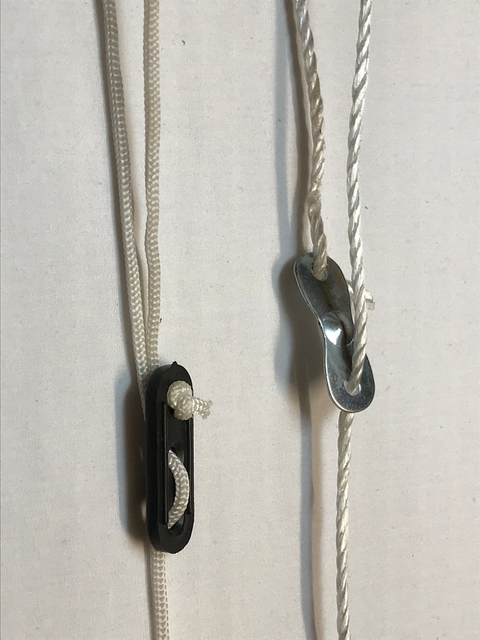
While these do work, they are designed for use with a tent stake, or other anchor where the loop at the end of the rope can be placed over it. It is more difficult to use this type of adjuster when tying a rope to a tree, for example, where you cannot slip it over the top of the trunk. One approach would be to use a smaller loop of rope or bungee cord around the tree, then hook the rope to that with a carabiner. (It can also be used if the adjuster is removed from the rope and replaced with the rope around the tree, but that isn’t as convenient.)
As commonly configured in the photo, with one end of the rope attached to the device, the rope can’t be shortened by more than half its length. So we need to get more creative!
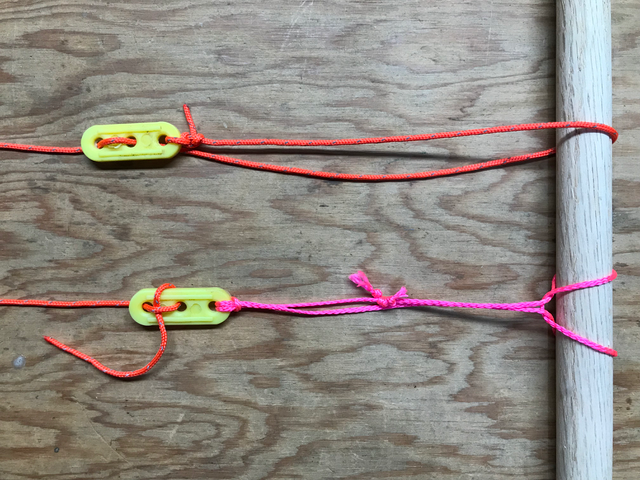
The original way that these were designed to be used is shown at the top. The rope is passed around the anchor and the plastic part is slid up the rope to tighten it. This limits the range of adjustment to half the length of the rope, and, with sloping antennas, the adjuster may get too high off the ground to reach easily. I often have a 10 m (30 ft) piece of rope on the end of my antenna wire, and might only need less than 3 m (10 ft) to my anchor. And I have found it much easier when I don’t have to pull all my excess rope through an hole in an anchor (or around a tree) to tie off the antenna.
The improved method, shown at the bottom of the photo, attaches the tensioner to the anchor, then the free end of the rope can be pulled up towards the antenna to take up slack. With this method, the tensioner is always within reach, and the rope can be shortened as much as desired. Also, this method can be used when it is inconvenient to pass a loop around the anchor, such as when tying to a tree. It can be tied with a folded end of the rope as well.
Note that plastic tensioners of this type can also be used as antenna insulators.
I recently have been experimenting with several other types. Like the previous rope tensioners, they seem to work best when the device is attached to the anchor, and the rope passed through it. To accomplish that, I have tied small loops of rope to the adjusters that can secure it to a nail, branch, hook, or whatever is available. Then I double over the rope to make an “end” that is passed through the device. These actually work quite well, although there is a danger of forgetting and leaving the tensioner attached to the tree when you are taking down the antenna. For that reason I prefer bright colored rope for the loop, to make it easier to see. There may be other ways to use these – I am still experimenting.
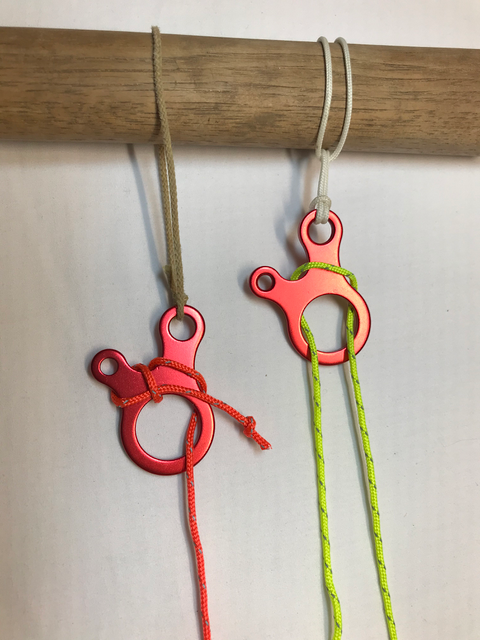
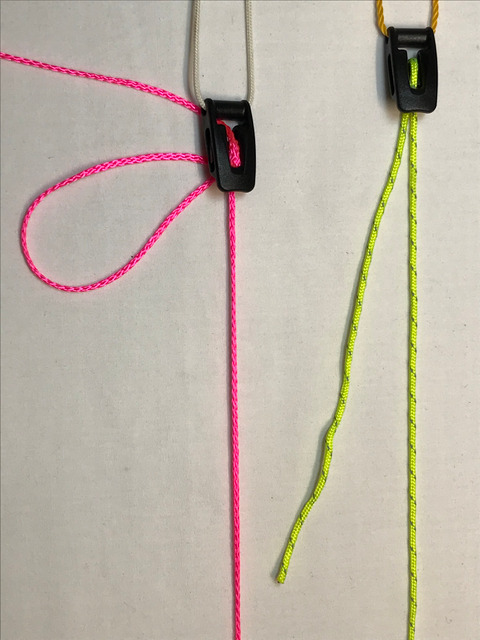
I recently found a variation on the traditional 3-hole rope tensioner with slots cut in the side of two of the holes, that is much easier to use, and overcomes most of the original shortcomings.
Now I pass a bight (folded end) of rope around the anchor, at whatever length is needed. The bight is passed through a hole in the tensioner and folded over the top to secure it. Then the rope is slipped into the slots on the sides. To adjust it, I pull up tension on the rope with one hand, and slide the tensioner along the rope with the other. If the rope is too small to hold well, I can make an extra twist of rope around the body of the tensioner, a shown in the following photos:
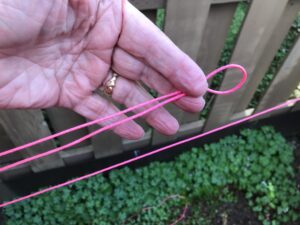
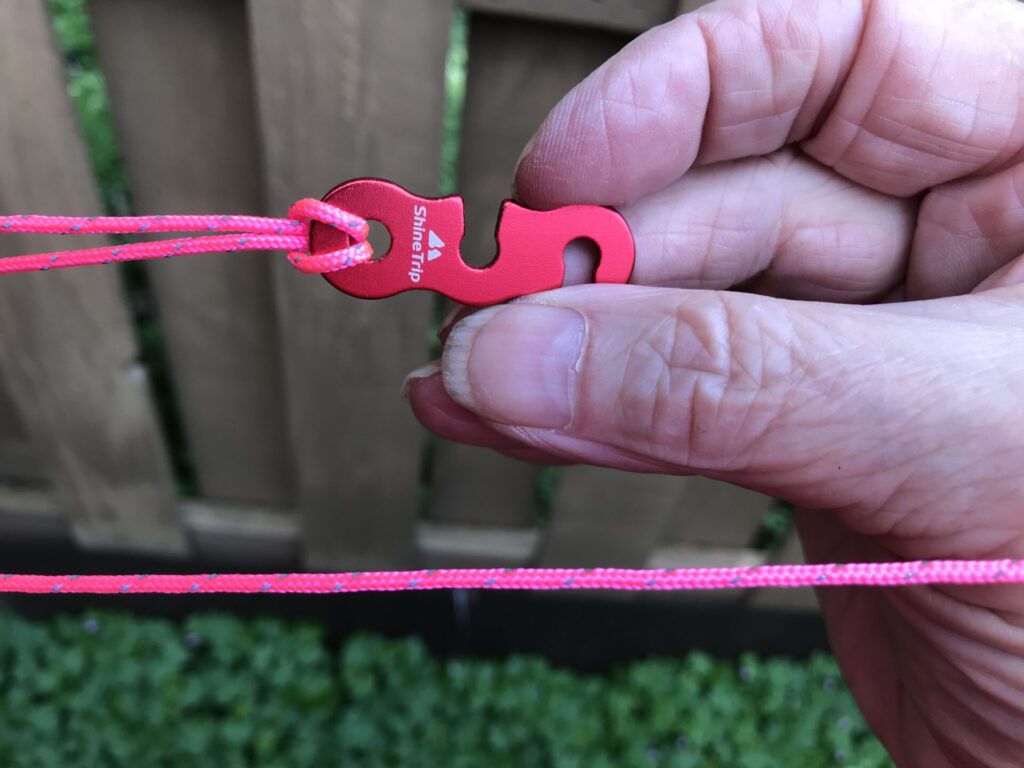
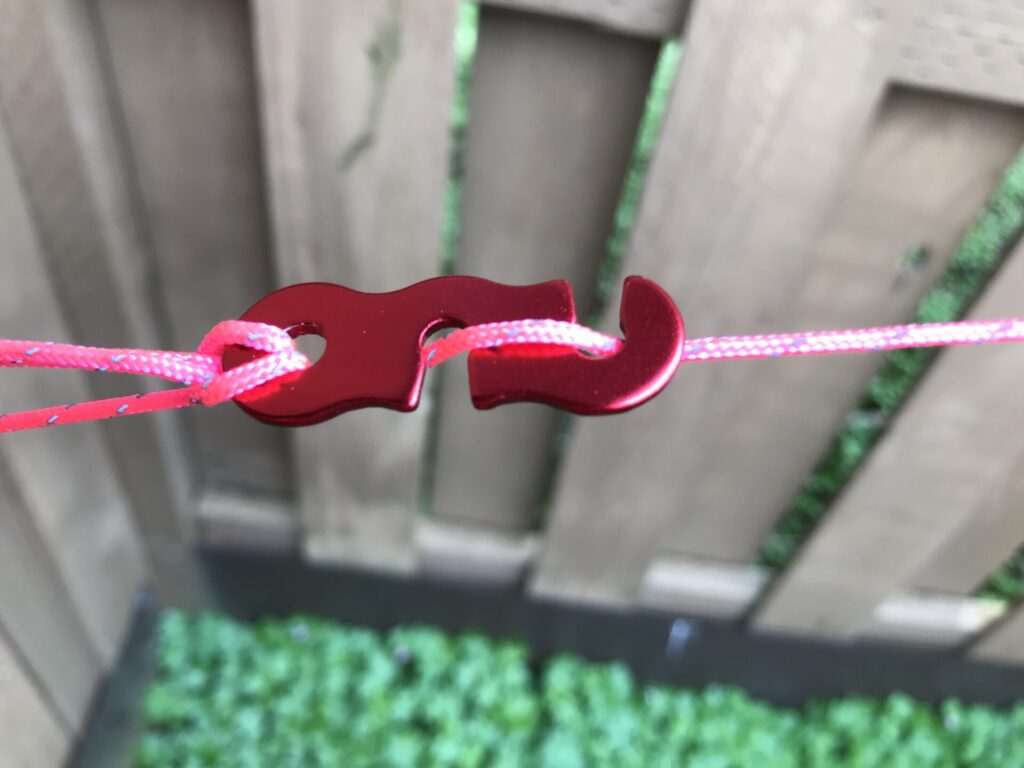
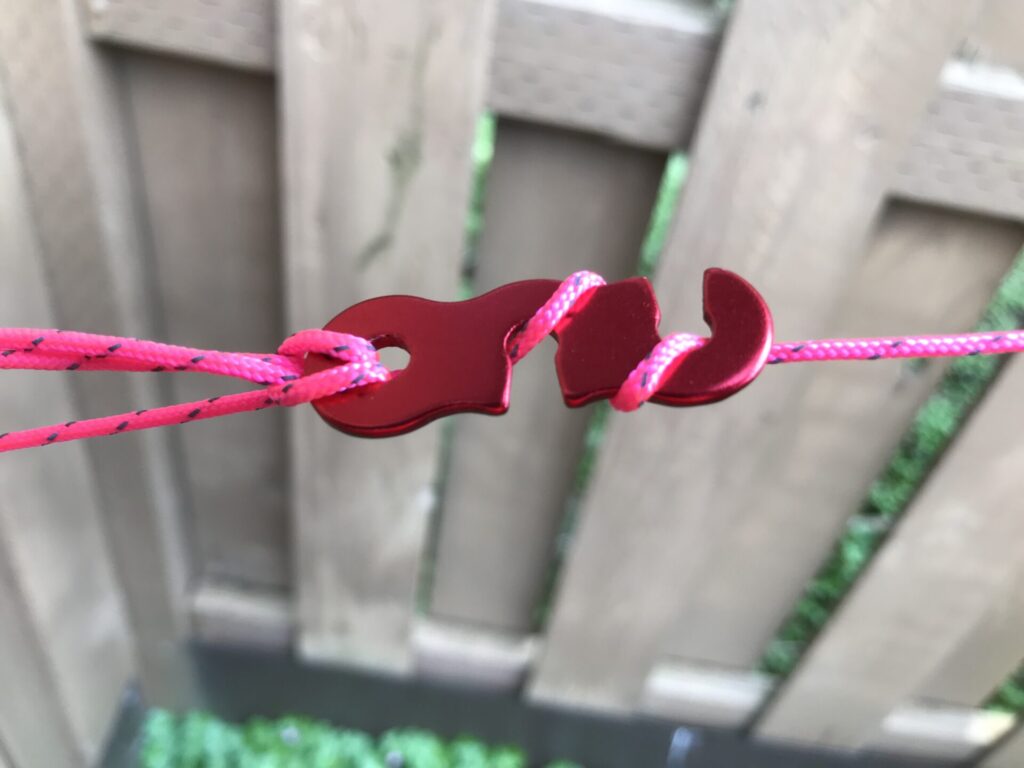
The red snail type of tensioners can be used in the same way. The bight of doubled rope is attached to the hole in the long arm, then the standing rope is pushed through the large hole and wrapped around the short arm.
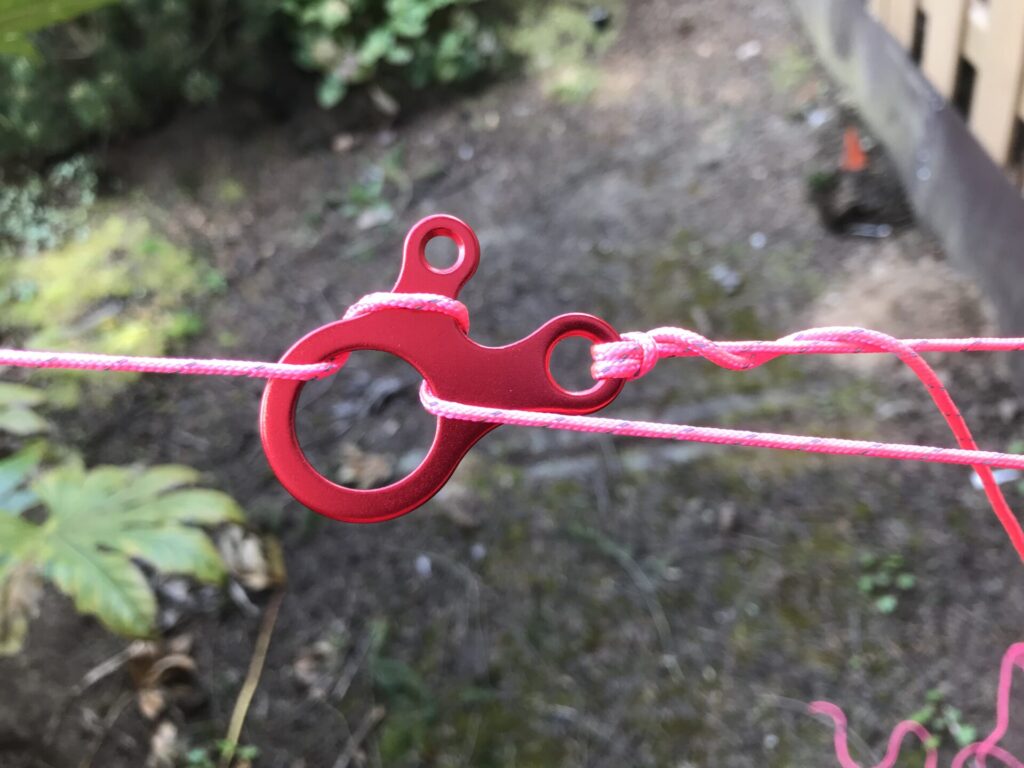
For these to work as shown, both sides of the rope passing around the anchor need to be under tension.
Note that, while these tensioners will work with rope up to at least 6 mm ( 1/4 inch ) diameter (including “550 Paracord”), the hole is too small to pass the doubled rope. In that case, the hole can be drilled larger, or the tensioner connected with a short loop of thinner rope, or a thin carabiner.
cord locks
The push-button cord locks used on drawstrings for clothing, also can work well here. By folding the rope and passing it through the hole, it makes a loop that can be slipped over, or clipped to, an anchor. The rope can be adjusted when the lock is squeezed, then locks into place when it is released.
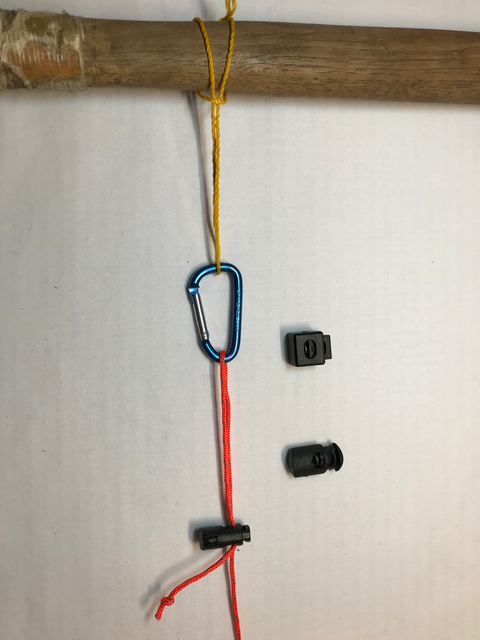
These also make great tuning adjustments for the ends of wire antennas.
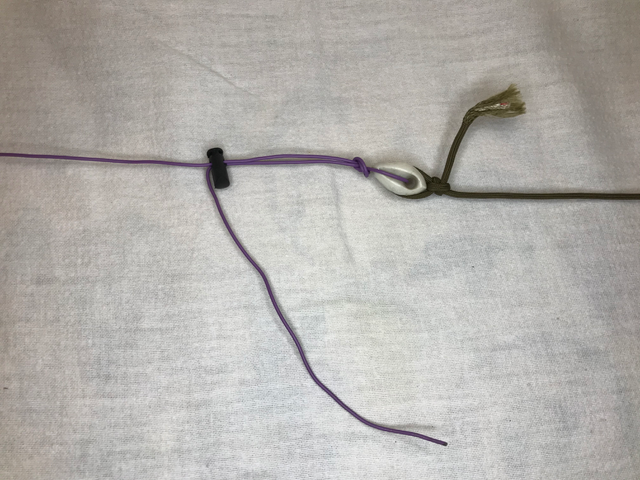
Here the end of the purple wire is tied to the insulator after the cord lock is slipped onto it. Then the free end of the wire is passed back through the cord lock. Sliding the cord lock up the wire raises the resonant frequency of the antenna, as more of the wire is folded back, while letting the end of the wire hang down. That allows field adjustment of wires if needed.
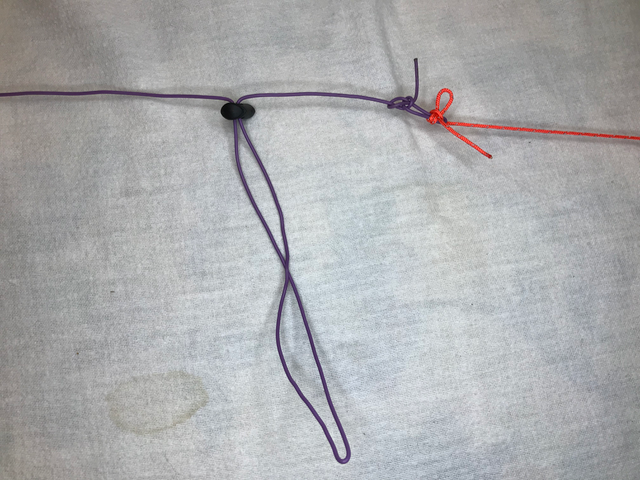
Cam-Jam®
The Cam-Jam® from Nite-Ize is a spring-loaded tensioning device built into a clip like a carabiner. These come in different sizes, and it is important to use the right size for your rope. I often use ropes that are a little bit too small for the ones I have, so I am still experimenting with these as well.
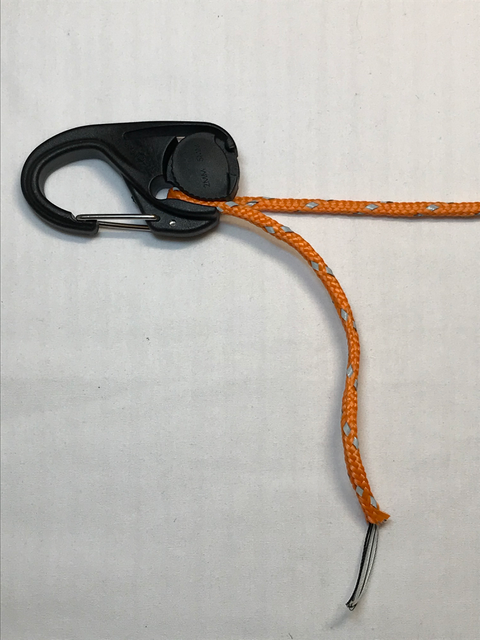
Often my rope is longer than I need for the anchor, but I don’t want to cut it, or pull all the excess rope through the hole. In that case, I can double the rope and pass it through the hole. With small ropes, the doubled portion can be locked in the cam, but larger ropes may not fit. In that case, make sure that the side under tension is locked in the cam, otherwise it may pull out.
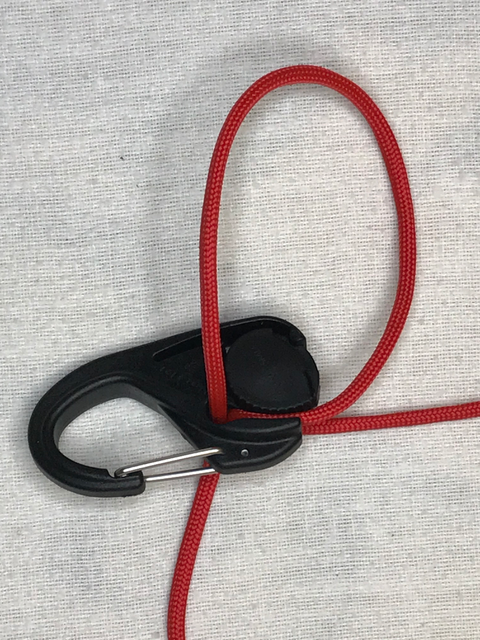
A related product from the same company is their “Figure 9” rope tensioner, where the rope is pulled into a tapered slot to hold it. These can be used several different ways – sometimes just pulling the rope into the tapered slot is enough to hold it if there is not a lot of tension.
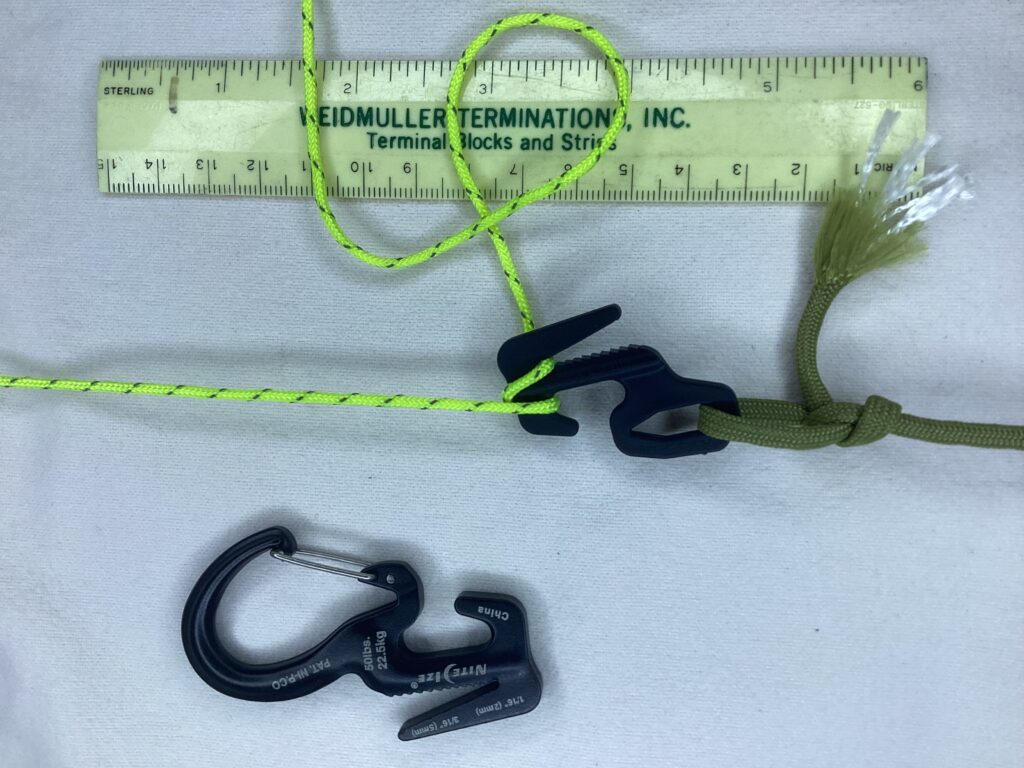
clothespins
I started using spring clothespins for field tuning of my dual-band dipole, and other antennas. But they are also useful for anchoring the ends of antennas to branches in the forest, and other things. This is often faster than trying to tie to them. The wooden ones may not grip as well as the plastic ones, but could be modified to give more friction. These may be particularly useful in cold weather when wearing gloves.
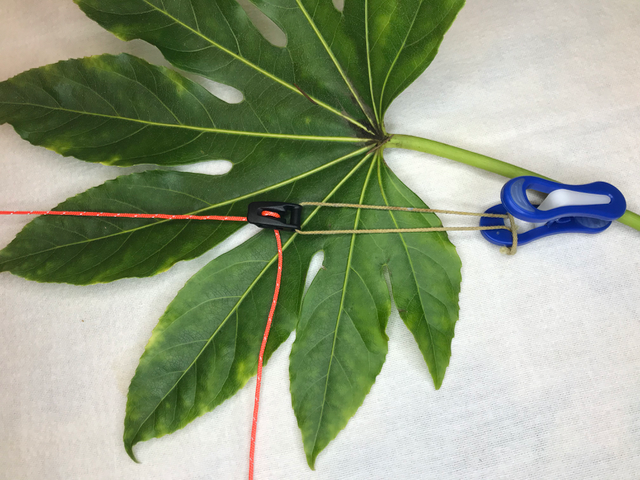
A “Bulldog Clip” or “Binder Clip” from the stationery store may give a stronger grip, especially on a rope.
twist ties / pipe cleaners
This is another quick way to tie off the end of an antenna to irregular objects. Twist ties are typically short plastic-covered wires used for sealing plastic bags. Pipe cleaners were originally used for smokers to clean out their pipes, but commonly are sold for children to twist into shapes. Either can be quickly twisted around a branch to secure an antenna.
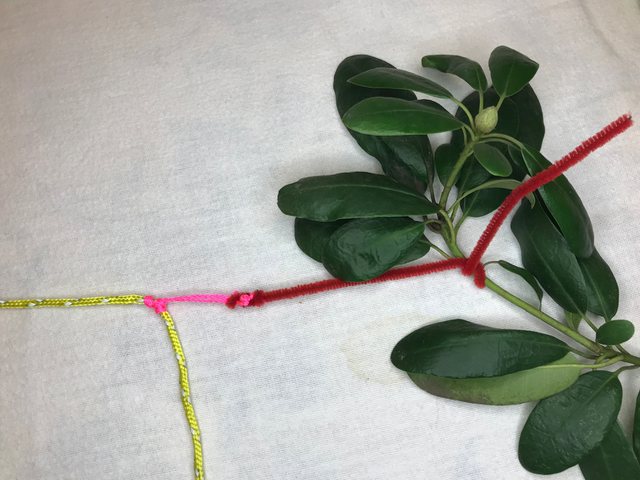
Any sort of stiff wire can be used the same way. One of my favorite way to hang a temporary VHF vertical antenna like a roll-up J-pole is to tie a wire hook on one end and hang it over a branch with a long pole. Then, to take it down, I just pull on the feedline so the hook wire straightens out and the antenna falls down.
split bolts
These are intended to connect wires together. They are in the form of a large bolt with a lengthwise slot: the wires are placed in the slot, then the nut is tightened. These are convenient for securing the ends of larger antenna wires to insulators, while still allowing the wire to be adjusted for tuning. They can also be used for quick splices if a wire breaks.
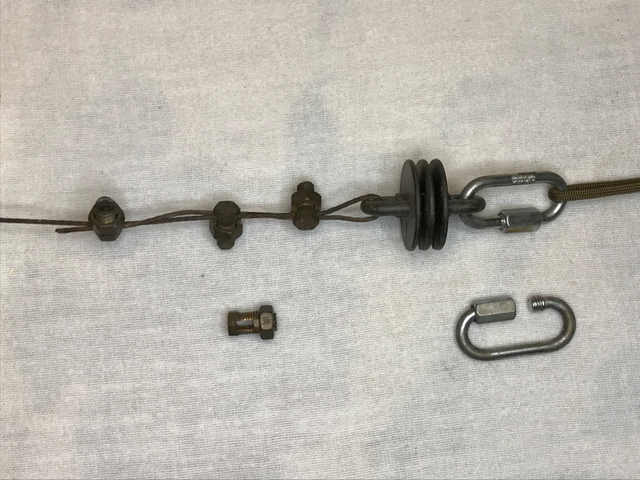
bungee cords and straps
Elastic bungee cords and various types of straps with a buckle or Velcro© closure are convenient for securing the base of masts to available supports. Usually this works best with at least two of them. The can also be used for bundling mast sections together for transport. With thin telescoping fiberglass masts, these are less likely to result in breakage than using metal brackets that focus the pressure at a single point.
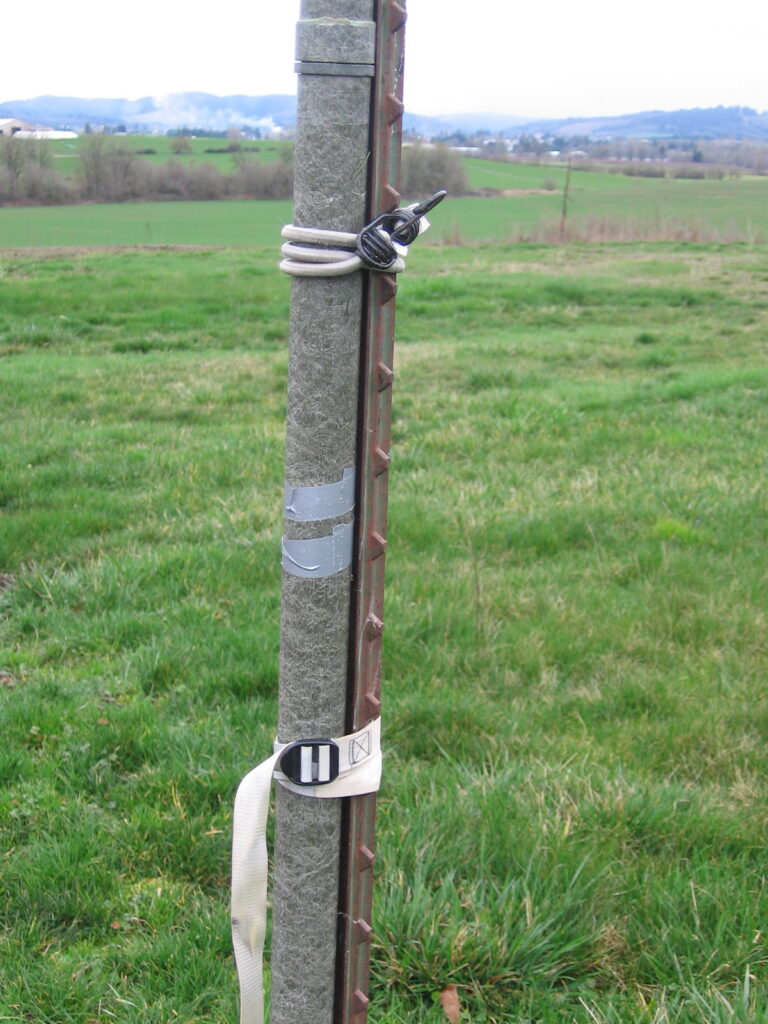
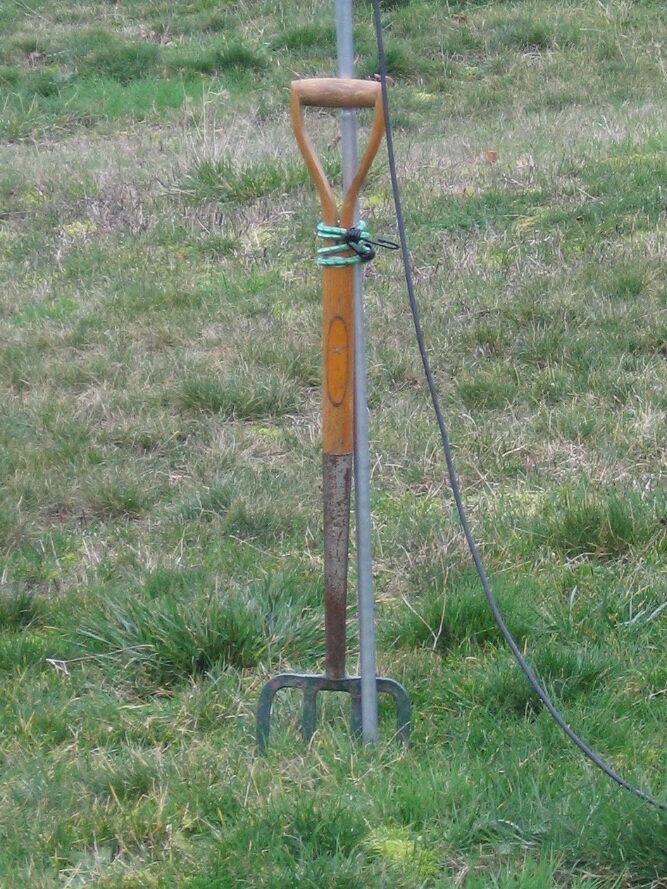
BACK TO: